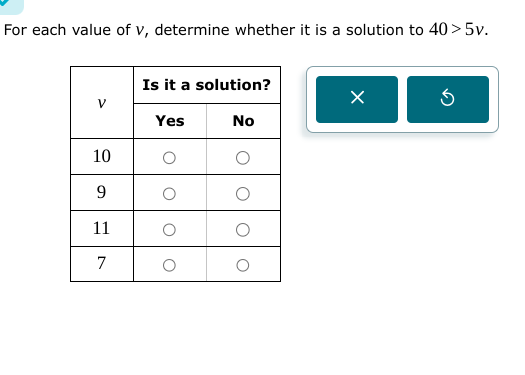For each value of v, determine whether it is a solution to 40 > 5v.

Understand the Problem
The question asks to evaluate if provided values of 'v' are solutions to the inequality 40 > 5v. For instance, when v = 10, the inequality becomes 40 > 5(10), which simplifies to 40 > 50, which is false. Therefore, 10 is not a solution. Repeat the same for 9, 11, and 7.
Answer
* v = 10: No * v = 9: No * v = 11: No * v = 7: Yes
Answer for screen readers
- v = 10: No
- v = 9: No
- v = 11: No
- v = 7: Yes
Steps to Solve
- Evaluate for v = 10
Substitute $v = 10$ into the inequality:
$40 > 5(10)$ $40 > 50$
Since 40 is not greater than 50, 10 is not a solution.
- Evaluate for v = 9
Substitute $v = 9$ into the inequality:
$40 > 5(9)$ $40 > 45$
Since 40 is not greater than 45, 9 is not a solution.
- Evaluate for v = 11
Substitute $v = 11$ into the inequality:
$40 > 5(11)$ $40 > 55$
Since 40 is not greater than 55, 11 is not a solution.
- Evaluate for v = 7
Substitute $v = 7$ into the inequality:
$40 > 5(7)$ $40 > 35$
Since 40 is greater than 35, 7 is a solution.
- v = 10: No
- v = 9: No
- v = 11: No
- v = 7: Yes
More Information
The problem involves substituting given values into an inequality and checking if the inequality holds true. The inequality holds true only when the left-hand side is strictly greater than the right-hand side.
Tips
A common mistake is to miscalculate the multiplication or to incorrectly compare the two sides of the inequality. For example incorrectly calculating the multiplication of $5 \times 7$ or thinking that 40 > 45 is true.
AI-generated content may contain errors. Please verify critical information